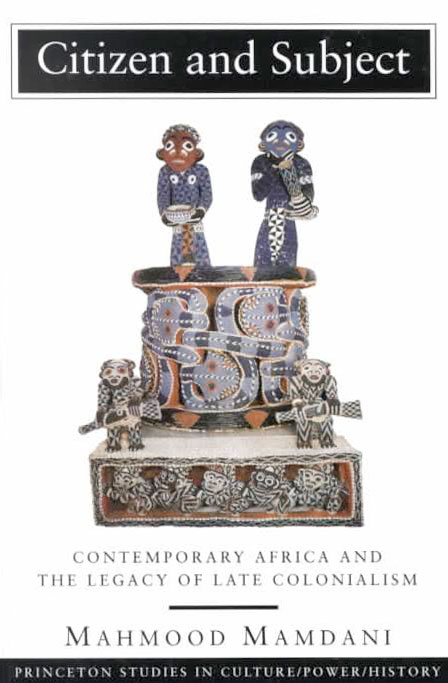Book review
By Yunus Momoniat
 Mahmood Mamdani’s seminal book, published in 1996, represented an important turning point in African Studies. In it, he challenged many beliefs long-held by Africanist scholars and made bold proposals that at the time cast a new light on the nature of colonialism and its effects on, and consequences for, Africa. The Ugandan scholar has now published a 2018 edition with a new preface that answers some criticisms of the earlier edition, and also considers the state of the continent two decades after his initial analysis.
Mahmood Mamdani’s seminal book, published in 1996, represented an important turning point in African Studies. In it, he challenged many beliefs long-held by Africanist scholars and made bold proposals that at the time cast a new light on the nature of colonialism and its effects on, and consequences for, Africa. The Ugandan scholar has now published a 2018 edition with a new preface that answers some criticisms of the earlier edition, and also considers the state of the continent two decades after his initial analysis.
The product of extensive engagement with the field of African Studies, the 1996 book presented a new type of argument about the way African colonies were controlled by European colonisers. Left-wing writers in particular had employed concepts derived from Marxist political economy, such as class, class formation and state power, and had emphasised the centrality of extra-economic coercion and forced labour. Mamdani’s analysis, without abandoning Marxism, focused on explaining how colonial powers needed an acceptable, economic and effective mode of control of colonial subjects, and thus he arrived at the idea of “indirect control”.
After slavery had been abolished, direct control was seen as racist, with white colonisers oppressing black subjects. Such a relation was too stark and too evidently transgressed an emerging language of rights and the rule of law. Imperial or colonial rule had to be made palatable and its true effects had to be disguised. It was cheaper and more practical to create indirect rule, which involved the transformation of custom into customary law and the reification of “tribes” and “tribal leaders” who would be backed by the state. Colonial states would thus become decentralised despotisms, using indirect rule to administer subjects from whom the rights of civil society were withheld.
A central element of the book, indicated in its title, is its consideration of the manner in which colonial authorities distinguished between citizens and subjects. The former were those ruled by a western-style civil – and apparently “civilised” – state; the latter were subjects of tribal “native authorities”. Citizens, mostly white colonisers and a few enfranchised Africans, had greater powers and status than those designated as subjects. This polarity is the basis for Mamdani’s concept of the bifurcated state, which essentially contrasted the position of urban people with that of rural people. This urban-rural bifurcation would later haunt post-independence leaders.
Mamdani’s use of the concept “subject” is close to the use of the term by Michel Foucault, who rejected the active sense of the term that implied agency. Rather, he saw the subject as an object – a pawn that could be engineered by structural forces. Like Foucault, too, Mamdani is concerned to show how power operates.
The tribes of the colonial period were tribes on steroids, backed as they were by state power. While tribes had previously been loose groupings that could gain or lose an individual’s loyalty and adherence, this was ruled out by the new customary law, which abolished the individual’s capacity to negotiate with the chief. Challenges to chiefly power, which had previously been allowed and even institutionalised, became impossible. A tribe now had a fixed identity, with strict rules presided over by the chief, and transgressions were criminalised.
The colonisers therefore invested tribal authorities with powers they had not held in the pre-colonial period. The new tribal authorities were hybrid forms and tribal leaders wielded the powers of incipient states, presiding not over a body of citizens but over a population of subjects with few, if any, rights. Colonial courts and institutionalised customary laws enforced this all-embracing power, reaching into every household and every individual fate.
Chiefs were thus the colonial powers’ instruments of indirect rule. The installation of chiefs and the rigidification of the groups they controlled solved the coloniser’s problem of how to rule large numbers of people with few personnel. It also solved another problem for colonial powers: how to subject a population through a recognisable form of rule rather than an alien one. Tribes without chiefs were promptly assigned a chief. Says Mamdani: “If there did not exist a clearly demarcated tribe with a distinct central authority, then one had to be created in the interest of order.”
The colonialist system of indirect rule through chiefs backed by state power effectively eroded kin-based and other forms of traditional or existing authority. South Africa, with its apartheid dismembering of the population into tribes with tribal authorities, or homelands, is often seen as exceptional, but Mamdani argues that it represented, rather, the typical model of colonial rule. Customary law was used to force subjects into the market economy. Transgressions such as failing to pay tax, trespassing and breach of labour contracts were all criminalised. The market eroded tribal and kin-based authority and freed individuals from servile relationships – but entry into market relations was through forced labour, taxation and extra-economic pressures.
Mamdani presents a scathing account of forced labour throughout Africa. He notes: “From considering force an African custom, it was but a short step to considering Africans as accustomed to force – as, say, a European may be to reason. So prevalent was this notion that at times even a doctor, whose job it was to reduce human pain, took to force to secure compliance from patients, in the process consoling himself of its morality.”
Despite his notion of the “subject” as discussed above, Mamdani does not rob peasants of agency. He shows how colonised peoples mounted resistance to colonialism. Indeed, the book is evenly divided: the first half consists of his analysis of colonialist power relations, while the second is a study of colonised peoples’ resistance to them, both rural and urban.
Forms of governance deployed during colonialism were not abolished with the advent of independence because they had shaped the societies they had exploited far too effectively to be consigned to history. Thus it was that post-colonial leaders found themselves also having to reckon with the determinations of the bifurcated state. Ethnic blocs and chiefs with established power bases could not simply be legislated out of existence, and rights could not simply be accorded to all by a civil state. After independence, the bifurcation identified by Mamdani persisted.
While deracialisation occurred, democratisation stuttered. Measures to reform the state, to democratise, were now necessarily urban-centred. “The tribal logic of native authorities easily overwhelmed the democratic logic of civil society,” the author writes. The capacity to appoint chiefs entailed power. Civil society remained an urban phenomenon, while in rural areas despotism was still in place, threatening democratisation in urban areas. Urban people thus faced “deracialisation from within and retribalisation from without”. Even radical new African states became prey to this logic – the despotism of the native authorities was centred on a rejection of the rule of law.
Some states made attempts to abolish chieftainship, but indirect rule persisted or was adopted at a later stage – by Uganda and Ethiopia, among other countries, for instance. In post-colonial Africa, populations could only be managed through their continued fragmentation into ethnic groups. In the case of Ethiopia, an ethnic federalism now obtains. Ethnicity has been politicised. As a consequence, throughout Africa, enfranchised majorities now rule while disenfranchised minorities struggle to exist. All this, Mamdani argues, is the result of indirect rule.
In the preface to the 2018 edition, Mamdani reflects on the reception of his influential book and deals with various objections raised by critics. Some of his major critics came from the left, who accused him of abandoning the key Marxist concepts of political economy noted above. But, as he argues, the use of these concepts simply failed to account for the role of tribalism in colonial African history – or “ethnicity”, as this concept has recently been euphemistically renamed. In South Africa, for example, the tribal and customary had become invisible to political economists. He felt compelled to look at the issue of the peasantry as a political question. More generally, he wanted to understand how the nature of custom changed from the pre-modern to the colonial modern, how it was instrumentalised by colonisers.
As we have seen, Mamdani’s argument is that in pre-colonial history ethnic groups or tribes were assimilationist, while in the colonial period tribes took on a fixed character, like that of “race”. Before colonialism, conquest saw the conquered brought into the tribe, which gained power by growing. Under colonialism, tribes became exclusive, backed by state power. “If the pre-modern was informed by an assimilationist logic, the modern colonial was informed by a segregationist logic,” says Mamdani. He also clarifies the nature of anti-colonial resistance, which he says is determined by the nature of existing power relations. In his argument, this crucially involved the difference between urban and rural resistance.
Reflecting on these and other critical responses to his book, he calls for greater specificity in the understanding of identity. As he was one of the first to show, in the case of Africa, modes of identification change as history unfolds and these are determined to an extent by the nature and history of the state, which has not been the same in each African country.
A second major objection to the book revolved around his conception of indirect rule, questioning its originality as well as its efficacy: critics asked whether indirect rule was specific to colonial rule. Some said that Mamdani’s formulation was nothing new, that Machiavelli had, five centuries before, suggested that indirect rule was preferable in colonies. Other critics went a step further, arguing that indirect rule was “the very essence of modern power”, both at home and in the colonies, casting doubt on the differences between colonial rule and governance in the metropole.
Mamdani’s point, I think, was to emphasise that Africans were ruled in a manner that grew out of a deeply entrenched racism that took steps to present itself as pragmatic, mindful of local customs and therefore free of racism. He was also concerned to demonstrate this by highlighting the differences between how people are governed in the colonies and in the metropoles. In the latter, forms of domination are mediated by institutions that shape the subjectivity of citizens, ensuring that schools instil discipline and prisons punish those who lack the appropriate, albeit right-enabled, submission. This was a form of brute force that did not show itself in the colonies. There, the indirectness of despotism took another form, and brute force had a structural role, with enforcement delegated to state-appointed chiefs. Mamdani’s point is that indirect rule is different in developing and developed countries, the former metropoles.
Mamdani thus replies to the second objection by insisting that the transformation of custom into customary law in Africa lay at the heart of indirect rule in the colonies, shaping the subjectivity of the colonised, unlike the mode of indirect rule through disciplinary institutions (schools, asylums, prisons) in the metropole, as theorised by Foucault. This law was practised in Africa and elsewhere, in India for instance, though in Africa it took on a very specific, racist approach. Thus, Mamdani sets indirect rule in Africa apart from other forms of it, calling for specificity.
This debate around the second objection is itself an unresolved problematic that bears on the nature of domination in developed and developing societies, but it is testimony to Mamdani’s theoretical prowess – and his tendency to raise questions that need to be explored. Some theorists and historians have argued that colonial rule was a precursor to modern power, and that this indirect mode of governance was perfected in the colonies before it was applied at home. This is an ongoing debate.
Mamdani’s book is evidently about more than modes of colonial domination. Among other things, it also includes a critique of methodologies used in African Studies. In brief, he argues for the constitution of the continent as an object of a specific discipline that is not distorted by reference to fields and methods used in the study of other regions, and also for more rigorous comparative research. Africa’s place in the globe is unique, and methods that cannot but see the continent teleologically – that is, as “backward”, compared to Europe – lead to misunderstanding and disastrous policies.
For me, the main force of Mamdani’s book lies in its challenge to the research approaches of scholars of Africa, and also the assumptions of post-colonial state officials and activists. He questions, for example, the prejudices that the national is not always superior to the tribal. Indeed, he argues that neither is always good or always bad. The same applies to social categories such as “peasant”, “chief”, “rural” and “urban”. His work lays the basis for a cogent account of how colonialism was transformed into what some have called neo-colonialism: the gradual measures – legal and other – through which the West established its domination over the continent, and was able to maintain it. It is a salutary lesson in historical scholarship.
Yunus Momoniat is a researcher and writer at South African History Online and an occasional political commentator.












